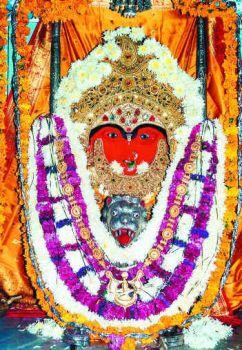Apr 14, 2025
Apr 14, 2025
Placed at the entry point of the fort wall of Old Patan on the banks of the Saraswati, the Kalika temple was built 1,000 years ago by Siddharaj Jaisingh Solanki. And the Goddess sustains the people of the city by her mere presence even today.
Wandering within the fort-walled city of Patan situated on the banks of the Saraswati in Gujarat can be a historical revelation. Here is a city which has seen much life and struggle. Now it has a quiet rhythm, not prone to the anxieties of a place like Gujarat's Ahmedabad. You can walk around to your heart's content and centuries simply fall away from one's consciousness.
Patan was founded in 746 A.D. by a Jain hero, Vanaraj Chavda, who built the Panchasara Parshvanath temple. It was a good beginning, for today we come across more than a hundred Jain temples in the city, despite centuries of destruction by invading iconoclasts. The Chavda dynasty came to an end in 942 A.D. when Samantsingh Chavda's nephew Mulraj I Solanki assassinated him and crowned himself the king. Though Solanki period (942 to 1244 A.D.) saw Patan rise to dizzy heights in temple architecture (Jain and Vedic), it was during Bhimdev I Solanki's rule that Mohammed Ghazni invaded Patan and went to Somnath and destroyed it for the first time (he was to do it 16 more times). Bhimdev rebuilt it. During the Solanki rule, Patan became a famous trading centre with legendary institutes of learning. The Solankis were followed by the Waghelas who reigned for 60 years.
During the reign of Sarangdev Waghela in the 14th century, Gujarat was invaded many times. When Karandev was the ruler, Ulugh Khan, commander of Alauddin Khilji looted and destroyed Patan completely and the city could never rise again to its former glory. Further, the people received a psychological setback when the invading soldiers seized Queen Kamaladevi and forced her to become Sultan Alauddin's begum in Delhi. Ahmed Shah founded Ahmedabad in 1412 A.D. and Gujarat's capital was shifted to Ahmedabad from Patan in 1468. With this, the famed city of Patan, once praised for its step-wells (the Rani-ni-Vav or Queen's Step-well is a tourist must) and temples, became a lost footnote in the history of India.
Through all these years of attack and defence and licking the wounds of defeat and conversion, the people never lost their faith in the guardian-deity of Patan. Built 1,000 years ago by Siddharaj Jaisingh Solanki, Kalika has sustained the people by her mere presence, and they pay homage to her even today with great faith.
 As I walk into the huge temple area (4,000 square feet), right on the fort wall is the image of Mahakali. Only the face is visible, and the nose-ring shines brilliant. She is Simhavahini and is decorated in red. A stone-studded crown gleams on her head. Beautiful fresh flower garlands cover her and her mount, the lion, is visible. The young priest intones the archana, with clear enunciation. He is followed by the singing of evening aarti by the assembled devotees.
As I walk into the huge temple area (4,000 square feet), right on the fort wall is the image of Mahakali. Only the face is visible, and the nose-ring shines brilliant. She is Simhavahini and is decorated in red. A stone-studded crown gleams on her head. Beautiful fresh flower garlands cover her and her mount, the lion, is visible. The young priest intones the archana, with clear enunciation. He is followed by the singing of evening aarti by the assembled devotees.
Moving towards the right, one comes upon the image of Bhadrakali. Actually, she is a gentle saumya form sculpted in marble. Next to her is a colorfully decorated Mahishasura Mardhini. I am told by the trustee that a secret underground passage from the sanctum sanctorum leads straight to the town of Siddhupur-on-Saraswati, 60 kilometres away. All the deities face a vast, open area with a huge havan-kund. Havans are performed regularly and even Muslims take part in them. Centuries of togetherness have erased the bitterness of the past, and a fine integration has taken place.
On the wall enclosing this area are old-time panels: a rishi performing tapasya, snake-men and women cast in marble, Durga holding court with trishul in hand. It is chastening to realize the basic unity of the nation, and, how Durga has pervaded the Indian sub-continent as the victorious deity whether in Jain Gujarat or Vedic Thanjavur. My mind rushes back to the eight-armed Durga in Tamil Nadu's Pazhayarai, the capital of ancient Cholas (before it was moved to Uraiyur, Gangaikonda Cholapuram, etc.) standing upon Mahisha. She carries weapons such as the trident, bow, ankusa and the discus. She had originally been in the palace of the Cholas but the rulers had set her up next to the fort wall at sometime. Durga has been the warrior's inspiration and guardian everywhere. Where have the kingdoms gone, and whither the warring armies? But Kalika is here, pervading a rare peace in the Patan temple (like the eight-armed Durga in Pazhayari). I salute and withdraw after watching the lovely parrots peeping out of their hollows in the wooded trunk of the ancient neem tree whose leaves bid me goodbye as I step out into the heroic dust of ancient Patan.
29-Jan-2006
More by : Dr. Prema Nandakumar